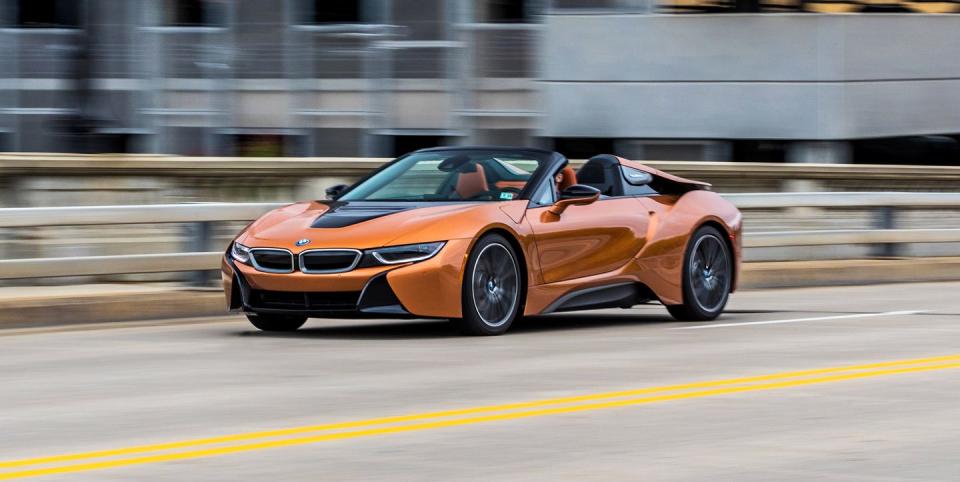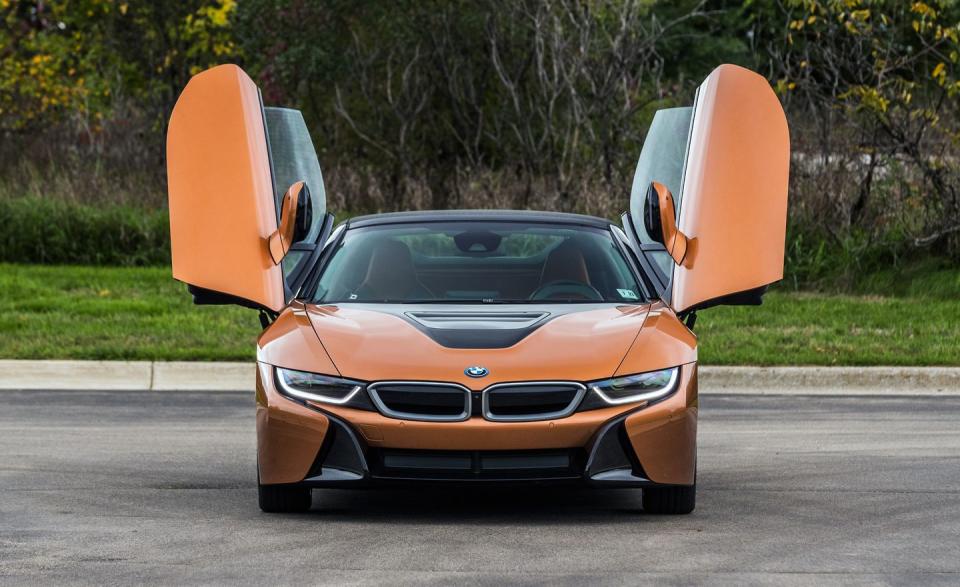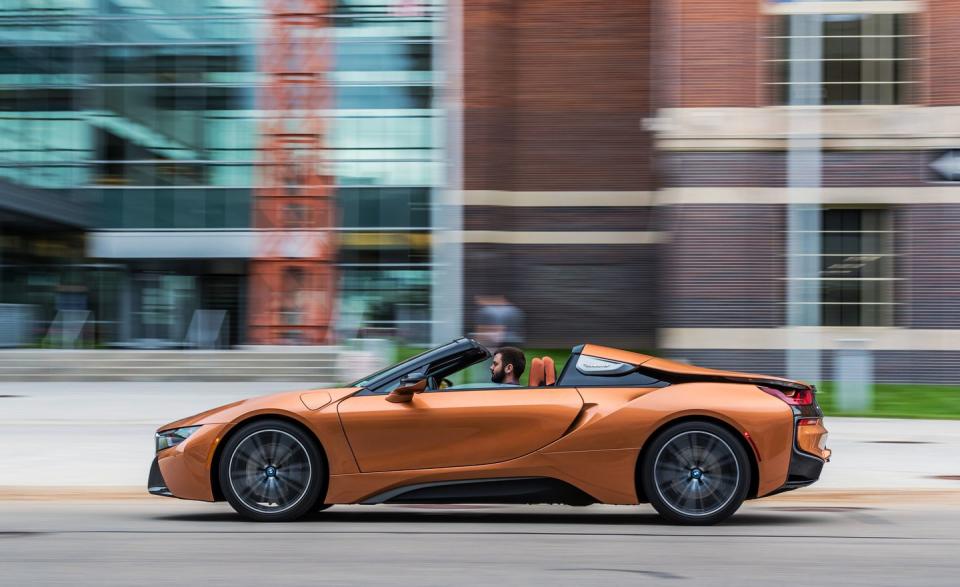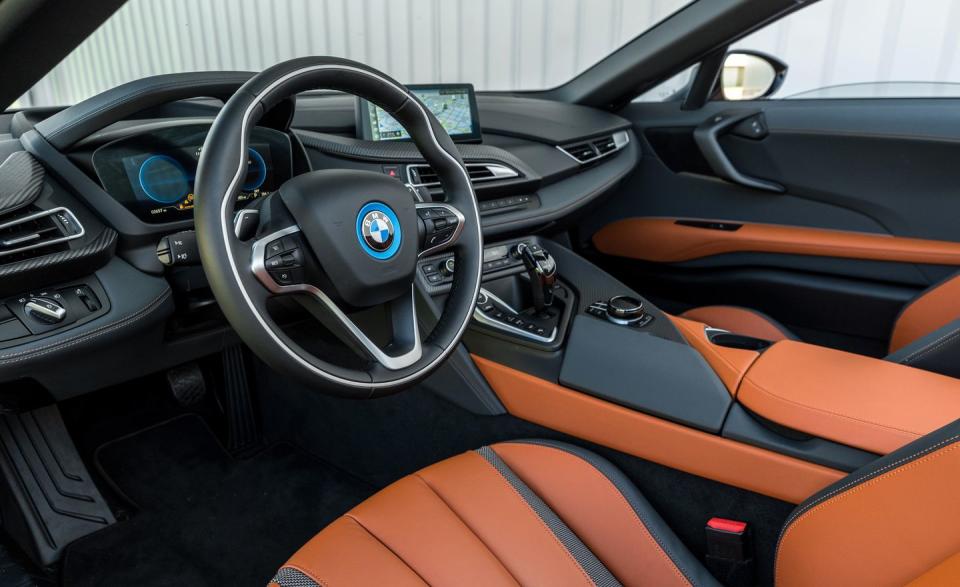2019 BMW i8 Roadster Makes a Showier High-Tech Showpiece

If Back to the Future were being made today, the part of the time-traveling DeLorean undoubtedly would be played by a BMW i8. While there may be wilder-looking supercars, the i8's intergalactic styling gives it the appearance of the car most likely to break the space-time continuum. After four years on the market, BMW has now rendered the i8 in convertible form, and the new roadster variant is an even more extroverted take on BMW's flashy supercar.
Mechanically, the roadster does not differ from the hardtop, although the i8's powertrain has been tweaked slightly for 2019. It's still a plug-in hybrid that has a mid-mounted turbocharged inline-three and an electric motor driving the rear wheels, along with a second, front-mounted motor driving the fronts. For 2019, the lithium-ion battery has been reconfigured for more capacity, at 11.6 kWh versus 7.1 before. BMW also increased the front motor's output by 12 horsepower to 141, and the total system output has surged an equal amount, to 369 horsepower.
The Numbers Issue
However, when a workaday BMW 3-series-specifically, the 2019 M340i-boasts 382 horses, 369 horsepower is pretty weak sauce for a car that looks like the i8. That's reflective of the i8's dual missions of performance and environmental friendliness. Because it's a plug-in hybrid, it's designed to operate as an EV as much as possible.
Choose EV mode, and the gasoline engine is sidelined (unless the accelerator is floored). With a fully charged battery, the i8 is good for 18 miles of electric motoring, according to the EPA. We managed 22 miles of electric motoring at 75 mph before the gas triple fired up during our highway fuel-economy test. (After the gas engine started delivering torque, it averaged a respectable 35 mpg.) The good news is that the car maintains the battery enough to keep the electric motors working as part of the hybrid system. Like every other EV this side of a Tesla, the i8 accepts the industry-standard J1772 plug (without an adapter). This means you can find a place to plug in on BMW's ChargeNow network (once an account is set up) or any other public option, at home with BMW's i charging station (or another aftermarket solution), or at home or on the road with the available TurboCord ($499), which accepts either 120-volt or 240-volt electricity. According to BMW, charging is three times quicker when using a 240-volt source. (It’s worth noting that the TurboCord was recalled this fall to fix a problem that could cause shock or fire; the defective units were replaced by BMW at no charge.)
In the default Comfort mode or in Eco Pro mode, the car starts out using battery power, blending in the gas engine as demand dictates but usually not until 65 mph or so. Slap the shift lever over to the left to activate Sport mode, however, and the engine runs all the time, making for quicker, more characterful acceleration and also charging the battery more quickly.
We clocked the roadster at 4.1 seconds to 60 mph and through the quarter-mile in 12.5 seconds at 113 mph. That's not slow, but it's well behind other mid-engine supercars such as the Acura NSX (3.1 seconds to 60, 11.2 through the quarter at 126 mph) and the McLaren 570S (2.9 seconds to 60, 10.7 through the quarter at 134 mph). In practice, the i8's hybrid powertrain accelerates seamlessly, bolstered by instant response from the electric side of the house with the gas engine coming to the forefront as speeds build. Despite its unusual configuration, the three-cylinder even sounds decent when you get on it, although the engine note is artificially enhanced. At startup, however, there's no sound at all beyond a brief spacey sound effect, and most of the time, the i8 motors away from the curb with all the aural drama of a Toyota Prius.
If the i8's acceleration is not supercar quick, its handling better lives up to the car's image. The mid-mounted engine contributes to a slightly rear-biased weight distribution, and the car turns in eagerly, seeming to pivot around its own axis. The steering is light, but response is linear and accurate, unmarred by BMW's Active Steering or any such nonsense. As fun as the i8 is to fling around corners, though, its relatively narrow rubber does not provide as much grip as its fat-tired competitors: It recorded 0.96 g on the skidpad, where the Acura NSX, the McLaren 570S, and even the Porsche 911 Carrera 4S all manage better than 1.00 g. Similarly, the i8 roadster's 165-foot stop from 70 mph is certainly not bad, but it pales in this competitive set, where most entrants can haul themselves down from that speed in 150 feet or less. The blending of regenerative and friction braking-often a challenge in hybrids-is smooth for the most part, although the brakes can be grabby when creeping along in traffic.
Roadster FTW
For those willing to accept sub-supercar performance as a tradeoff for the i8's future-think green benefits, the roadster variant has it all over the coupe. The look is even more radical, with fairings extending rearward over the engine cover, between which is a vertical rear window that powers up and down; leave it up to help combat wind buffeting. Lowering the fabric top is an all-electric dance that takes only 16 seconds and can be performed on the move at speeds up to 31 mph. Ducking under the i8's dihedral doors makes graceful ingress a challenge (getting out is a little easier), but they're still undeniably cool.
Once inside, drivers will find the cabin easy to acclimate to, with BMW's iDrive infotainment system operated by the familiar clickwheel and featuring a logical menu structure. The screen-based instrument cluster varies its appearance with the drive mode, and a welcome head-up display is standard. The interior uses mostly off-the-shelf BMW elements but is extremely well finished, with rich leather. The roadster ditches the coupe's vestigial rear seats, but in their place is a useful in-cabin stowage space behind the front seats. The trunk is located at the rear and measures a reasonable five cubic feet; a second, smaller front trunk is home to the charging cord.
At a starting price of $164,295, the roadster is $15,800-or just over 10 percent-more expensive than the coupe. The loss of the fixed roof does not materially diminish the car's performance, but that's not really what the i8 is about anyway. This car is more about making a statement that mid-engined sports cars can thrive in a future environment and look cool doing so. The roadster version does the former just as well and the latter far better.
('You Might Also Like',)

 Yahoo Autos
Yahoo Autos 


